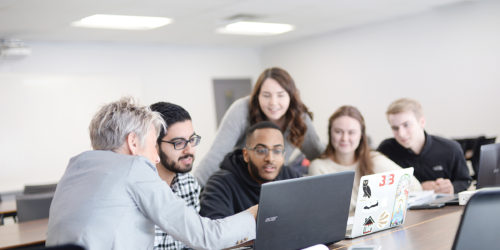Promoting Attendance with International Students
How can you best prepare international students to attend your classes?
The Contexts for International Students at Conestoga
Many international students have just arrived and have not yet had much opportunity to seek your guidance and may be sharing bad advice with each other. One idea students may have is that attendance is not required. We all know that high attendance correlates with a greater likelihood of learning and success. Your advice is crucial to getting the students on track. The theory of Acculturative Stress says that finding a “trusted leader” such as a faculty member who will provide guidance is one of the most important ways to combat acculturative stress.
Some faculty have identified concerns regarding attendance already being of concern in Week 2. International students, like all students, are expected to be in class as scheduled. The Study in Canada site explains what a study permit is and that students must be “actively pursuing their studies” and “making progress towards completing their program.” This has been interpreted to mean attending a reasonable number of classes, participating in class learning activities and completing assessments.
International students are legally permitted to work up to 20 hours on or off campus. Like many domestic students, international students find work is necessary to help cover living expenses. However, work is not an excuse to miss classes or leave classes early.
Suggestions and Innovations
If this is one of your first times teaching a cohort of international students, you may be experiencing surprises too. Please reach out to Teaching & Learning to consult with one of us, or to share your ideas related to intercultural teaching.
Monitor attendance and let it be seen that you are monitoring. Use the eConestoga attendance tracker so that messages can be automatically sent out to those who miss a class. Reach out to eConestoga if you need help with setting this up. See more information on ways to take attendance for in-person an synchronous online classes in the Hub post, Taking Class Attendance.
If using a paper-based method, print only the official attendance lists from the Employee Portal. Never distribute a list that shows the student name and student number together or request students to write both their name and number on a page that is circulated. The student number is confidential.
To the best of your ability, learn student names. The ability to identify students directly by name goes a long way to creating a climate of accountability and strong interpersonal respect in a classroom.
Start class on time and end 10 minutes before the end of the scheduled time. Make note of lateness and students who are leaving at break. Some faculty have shared that students are arriving for attendance and then leaving, so they have begun taking attendance at the start and end of the class session. Attendance does not count towards a grade, so it is a bit of a balance between encouraging attendance and participation, and allowing the students to make their own choices. It may be that students do not yet understand how our outcomes-based system works. They may be expecting a high stakes final exam which can help them reclaim their mark. Be sure to review the evaluation scheme a few times.
Inform students that if they are unable to attend class, they should report short-term absences using the absence reporting system in the Conestoga Student Portal. Here is a sample statement you may wish to deliver in class:
Attendance at all classes is expected. Dates for assessments are given at the start of the semester in the Instructional Plan. If you must miss a class where an assessment is scheduled, please indicate the absences in the Conestoga Student Portal and email me as soon as possible to discuss the next steps.
Review any requests for missing or making up evaluations carefully. Religious observations, family emergencies, etc. do come up. Check with your Chair if you are not sure what to reply to a student requesting an evaluation delay or prolonged absence.
Do not agree to have all labs and tests at the start of the class. Some faculty have had students request this to facilitate students getting rides home or working.
Do not agree to save all of the break time till the end of the class, even if students request this so as to leave early. The break time is for you and the students to refresh so that more learning can occur.
If you talk about the value of the learning for the future workplace and a student(s) tell you they just need a credential and then can get any job, have a reply ready. Mine would be, “Thank you for sharing but I am here to educate. My expectation is that you are here to learn. In order to pass this course you must achieve the learning outcomes and obtain a mark of at least ___ %.” Encourage the student to reframe their thinking with a long-range vision of obtaining a credential, working in a particular field, and building a career, as well as obtaining immigration status and a job.
If a student is not attending, check in with your colleagues, your Coordinator and/or your Chair as agreed on, so everyone knows that a student is not attending. Learn more about strategies for managing student absence in the related post, When Students are Absent From Class and When Students are Absent from Group Work.



